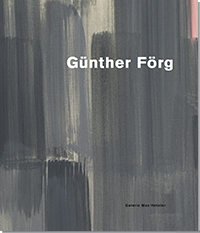Artist's Books / Special Editions
Almond, Darren: All Things Pass
Almond, Darren / Blechen, Carl: Landscapes
Brown, Glenn: And Thus We Existed
Butzer, André: Exhibitions Galerie Max Hetzler 2003–2022
Chinese Painting from No Name to Abstraction: Collection Ralf Laier
Choi, Cody: Mr. Hard Mix Master. Noblesse Hybridige
Demester, Jérémy: Fire Walk With Me
Dienst, Rolf-Gunter: Frühe Bilder und Gouachen
Dupuy-Spencer, Celeste: Fire But the Clouds Never Hung So Low Before
Ecker, Bogomir: You’re NeverAlone
Elmgreen and Dragset: After Dark
Förg, Günther: Forty Drawings 1993
Förg, Günther: Works from the Friedrichs Collection
Galerie Max Hetzler: Remember Everything
Galerie Max Hetzler: 1994–2003
Gréaud, Loris: Ladi Rogeurs Sir Loudrage Glorius Read
Grosse, Katharina: Spectrum without Traces
Hatoum, Mona (Kunstmuseum
St. Gallen)
Eric Hattan Works. Werke Œuvres 1979–2015
Hattan, Eric: Niemand ist mehr da
Herrera, Arturo: Boy and Dwarf
Hilliard, John: Accident and Design
Horn, Rebecca / Hayden Chisholm: Music for Rebecca Horn's installations
Horn, Rebecca: 10 Werke / 20 Postkarten – 10 Works / 20 Postcards
Huang Rui: Actual Space, Virtual Space
Kowski, Uwe: Paintings and Watercolors
Mikhailov, Boris: Temptation of Life
Mosebach, Martin / Rebecca Horn: Das Lamm (The Lamb)
Neto, Ernesto: From Sebastian to Olivia
Oehlen, Albert: Mirror Paintings
Oehlen, Albert: Spiegelbilder. Mirror Paintings 1982–1990
Oehlen, Albert: unverständliche braune Bilder
Oehlen, Pendleton, Pope.L, Sillman
Oehlen, Albert | Schnabel, Julian
Phillips, Richard: Early Works on Paper
Riley, Bridget: Paintings and Related Works 1983–2010
Riley, Bridget: The Stripe Paintings
Riley, Bridget: Paintings 1984–2020
Roth, Dieter & Iannone, Dorothy
True Stories: A Show Related to an Era – The Eighties
Wang, Jiajia: Elegant, Circular, Timeless
Wool, Christopher: Westtexaspsychosculpture
Zhang Wei / Wang Luyan: A Conversation with Jia Wei
 |
|
|||
Günther Förg German / English
|
The focus of this catalog lies on a series of six large-format paintings that Günther Förg originally produced in 2003 for a group show at the baroque castle of Dyck. The paintings are held in various shades of gray, with bright accents in red and pink, and were fit by the artist into the 80-inch wall panels of his exhibition room in the castle. When in 2017 they were shown at Galerie Max Hetzler in Berlin, this sitespecific work turned into a powerful series of pure, absolute paintings. Reinforced by a selection of smaller paintings from the same time, the complete historical dimension of these works becomes visible—abstract, almost minimalist but still evoking an idea of nature. Central to their success is Förg’s very immediate manner of painting, as described by Matthias Buck in his essay: “The viewer, standing back from these paintings, can take up the perspective of the artist at work. While we have the picture in its present totality before us, we also have an overview of its path to completion. The painting comes across not as the overwhelming result of an artistic genesis that remains the secret of its creator, but as a transparent entity which, precisely because it has no secret, amazes us with the simplicity of means by which very complex pictorial effects have been created.”
Günther Förg in the Hall of Mirrors … The paint is applied in vertical stripes that do not run exactly parallel to the sides of the picture, but have a slight tendency to veer to the right. This probably resulted from the movement of the brush, but has the welcome side-effect of creating a mild tension between the stripes and the picture’s rectangle. In their proportions these stripes come across as enlarged brushstrokes. They are fields and lines at the same time. Each is composed of numerous pale and dark strands. We can see at a glance that the paint was only applied in one direction. Time and again, the brush glides downwards. Where it first touches the canvas, the appearance is frayed. The first point of contact between brush and surface is visible as such. Then the bristles slide evenly down the canvas. This does not seem to happen at any great speed. The movement is free and controlled at the same time. A tamed gesture. The pictures are structured by repetition and simplicity of movement. This is gestural painting in ritual mode. Conceptualized spontaneity. The pressure applied to the brush is moderate; occasionally the paint begins to give out, but before it does so completely, the brush is lifted. None of the stripes extends from edge to edge. Since the whole process is so transparent, each individual strand of colour remains individually identifiable. The eye slides down it. Viewing becomes a sensuously meditative act. We might compare it to watching raindrops rolling down a window pane. The oft-noted laconic aspect of Förg’s paintings is imbued with a certain melancholy.
... |